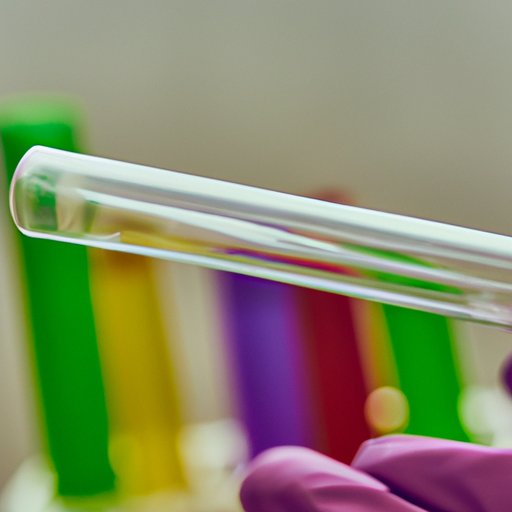Introduction
A test tube is one of the most commonly used pieces of equipment in laboratories across the world. It is a thin-walled glass tube with a rounded bottom and a flat top, used to hold small samples or to perform experiments. Test tubes have been around since the early 19th century and have played an important role in the development of modern science. In this article, we will explore what a test tube is used for in science and how it can be used to create solutions, analyze chemical reactions, and more.

Exploring the Basics of Test Tube Use in Science
Test tubes are used for a variety of purposes in science. They are often used to hold small samples for observation or experimentation, such as bacteria cultures or chemical compounds. Test tubes are also used to mix chemicals together to form new compounds. Test tubes can also be used to heat or cool substances, or to store liquids or solids.
There are two main types of test tubes: round-bottomed and flat-bottomed. Round-bottomed test tubes are best suited for mixing and heating, while flat-bottomed test tubes are better suited for storing liquids or solids. Test tubes come in different sizes, materials, and shapes, so it is important to choose the right type of test tube for the experiment.
The Versatility of Test Tubes in Scientific Experiments
Test tubes are versatile tools that can be used for a variety of purposes in scientific experiments. For example, test tubes can be used to create solutions, which are mixtures of two or more substances. Solutions can be used to study the effects of different chemicals on organisms or to measure the concentration of a particular substance. Test tubes are also often used to examine the effects of temperature on certain biological processes.
Test tubes can also be used to analyze chemical reactions. When two or more chemicals are mixed together in a test tube, they may react with each other and produce new compounds. By studying the products of these reactions, scientists can gain insights into the properties of the chemicals involved and the mechanisms of their interactions.

A Comprehensive Guide to Using Test Tubes in Scientific Research
When using test tubes in scientific research, it is important to understand the role of test tubes in analyzing chemical reactions. Test tubes can be used to observe the colors, odors, or bubbling of a reaction, as well as to measure the amount of product produced. Test tubes can also be used to measure the rate of reaction, which can help scientists understand the mechanism of a reaction.
When handling test tubes, it is important to take safety precautions. Test tubes are made of fragile glass and can easily break if mishandled. Therefore, it is important to use gloves when handling test tubes and to avoid dropping them. Additionally, it is important to use the appropriate container for the size of the test tube, as larger containers can cause the test tube to break.
Conclusion
Test tubes are essential tools in scientific research. They can be used to create solutions, analyze chemical reactions, and observe the effects of temperature on certain biological processes. Test tubes are also versatile and can be used in a variety of experiments. However, it is important to take safety precautions when handling test tubes, as they are made of fragile glass and can break easily.
In conclusion, test tubes are invaluable tools in scientific research and can be used for a variety of purposes. From creating solutions to analyzing chemical reactions, test tubes provide scientists with an array of opportunities to conduct experiments and gain insights into the world around us.
(Note: Is this article not meeting your expectations? Do you have knowledge or insights to share? Unlock new opportunities and expand your reach by joining our authors team. Click Registration to join us and share your expertise with our readers.)
